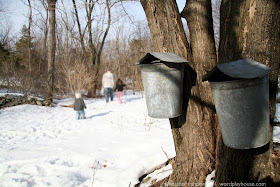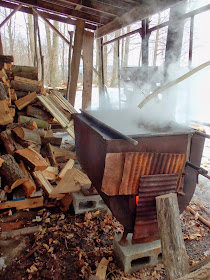Spring is upon us here in central New York state and there is much to be done around this little homestead. Therefore, as difficult as it is for me to put the brakes on my blogging habit, that's what I'm doing. I'll be off for a week… or two.
If you have not yet done so, I encourage you to sign up and receive new blog posts (when I start blogging again) by e-mail. There is a place to sign up on the right side of this page.
Before I go, I'd like to retract something I wrote here earlier this year. You may recall that I said I wasn't going to have a very big garden in 2014. I expected to be too busy with my Planet Whizbang business this year. Well, I take it back. I'm making the time to have a big and productive garden this year! Here's why...
I am particularly alarmed by the recent and ongoing events in Ukraine. There is sufficient evidence to indicate that the United States government played a key behind-the-scenes role in the destabilization of that country. Multinational banking interests, along with global energy and agribusiness corporations stand to benefit greatly. Follow the money.
The corporate news media in the US is unreliable. It has clearly become a propaganda arm of the federal government. They routinely discuss trivial matters as if they are important, and feed us misinformation about things (like the situation in Ukraine) that are critically important.
I have become skeptical of everything our government is doing in the realm of "foreign relations." I do not believe it is in the best interests of the American people to have our government stirring up trouble with the Russians over an area of land that is on the Russian border, that used to be a part of Russia, and that is largely populated by people who identify themselves as Russian. In short, Ukraine is of major strategic importance to Russia and has always been. What strategic importance is that country to the people of America? None.
For our government to be over there causing trouble for Russia, then criticizing them for responding to the trouble, is something I don't understand. There is a whole lot more to this than meets the eye. And, like I said, I'm alarmed.
There isn't much we can do about globalist elites (American politicians among them) perpetrating their self-serving corruptions in so many places around the world. But there is something that we can do to be better positioned to deal with the difficulties that will, in time, surely befall the people of this country...
We can be more and more proactive about providing for our food needs, apart from the industrial providers. Which means, we can get more serious about growing food for ourselves and our families. And that's what I intend to do.
If you are getting more serious about your own gardening pursuits this year, I want to point out that I have numerous Planet Whizbang products that can help you be a more successful gardener…
1. The Planet Whizbang Idea Book For Gardeners
2. The Planet Whizbang Wheel Hoe
3. Whizbang Bucket Irrigation Kits
4. Planet Whizbang T-Post Trellis Span Y-Holders
5. Planet Whizbang T-Post Grape Trellis Fittings
6. Whizbang Garden Cart Plans
For more inspiration and information, check out This Archive of My Garden Writings.
And finally, until we meet here again, I want to leave you with some pleasant, reflective music to listen to…
If you have not yet done so, I encourage you to sign up and receive new blog posts (when I start blogging again) by e-mail. There is a place to sign up on the right side of this page.
Before I go, I'd like to retract something I wrote here earlier this year. You may recall that I said I wasn't going to have a very big garden in 2014. I expected to be too busy with my Planet Whizbang business this year. Well, I take it back. I'm making the time to have a big and productive garden this year! Here's why...
I am particularly alarmed by the recent and ongoing events in Ukraine. There is sufficient evidence to indicate that the United States government played a key behind-the-scenes role in the destabilization of that country. Multinational banking interests, along with global energy and agribusiness corporations stand to benefit greatly. Follow the money.
The corporate news media in the US is unreliable. It has clearly become a propaganda arm of the federal government. They routinely discuss trivial matters as if they are important, and feed us misinformation about things (like the situation in Ukraine) that are critically important.
I have become skeptical of everything our government is doing in the realm of "foreign relations." I do not believe it is in the best interests of the American people to have our government stirring up trouble with the Russians over an area of land that is on the Russian border, that used to be a part of Russia, and that is largely populated by people who identify themselves as Russian. In short, Ukraine is of major strategic importance to Russia and has always been. What strategic importance is that country to the people of America? None.
For our government to be over there causing trouble for Russia, then criticizing them for responding to the trouble, is something I don't understand. There is a whole lot more to this than meets the eye. And, like I said, I'm alarmed.
There isn't much we can do about globalist elites (American politicians among them) perpetrating their self-serving corruptions in so many places around the world. But there is something that we can do to be better positioned to deal with the difficulties that will, in time, surely befall the people of this country...
We can be more and more proactive about providing for our food needs, apart from the industrial providers. Which means, we can get more serious about growing food for ourselves and our families. And that's what I intend to do.
 |
| Squash seedlings, 2013 |
If you are getting more serious about your own gardening pursuits this year, I want to point out that I have numerous Planet Whizbang products that can help you be a more successful gardener…
1. The Planet Whizbang Idea Book For Gardeners
2. The Planet Whizbang Wheel Hoe
3. Whizbang Bucket Irrigation Kits
4. Planet Whizbang T-Post Trellis Span Y-Holders
5. Planet Whizbang T-Post Grape Trellis Fittings
6. Whizbang Garden Cart Plans
For more inspiration and information, check out This Archive of My Garden Writings.
 |
| Tomatoes, 2013 (on Whizbang T-post trellis spans) |
And finally, until we meet here again, I want to leave you with some pleasant, reflective music to listen to…
That song is part of David Farley's new CD, and you can listen to the whole CD At This Link.
If you go to that link, play close attention to the beginning of song #5 (Stella). That was going to be the lead-in music to my Agrarian Reader podcast (which I decided not to follow through with).
I'll be back here in a week... or two.
Best wishes,
Herrick Kimball
P.S. I have finally posted another old excerpt to my Agrarian Nation blog. Check it out: Earth Ovens—1869
P.S. I have finally posted another old excerpt to my Agrarian Nation blog. Check it out: Earth Ovens—1869
 |
| Me & Futureman, 2013 |



























